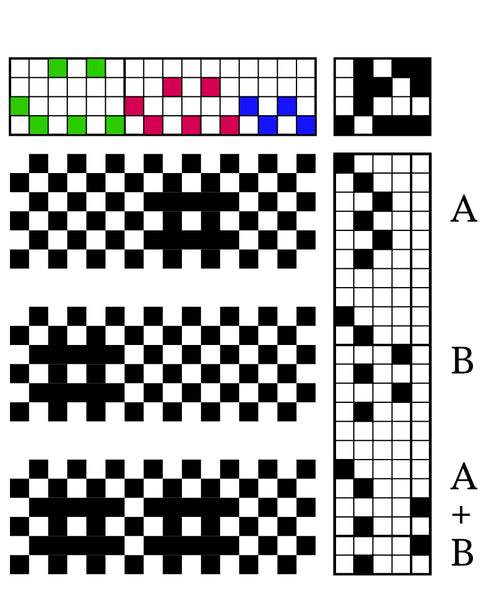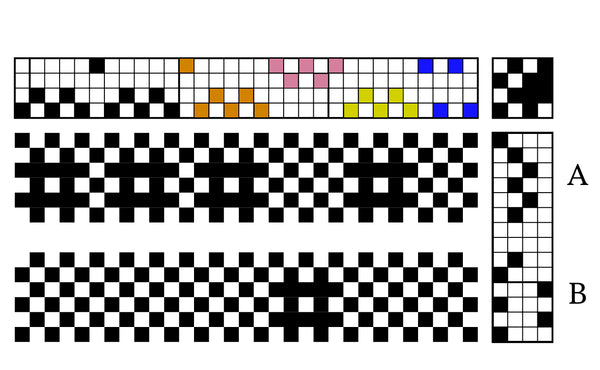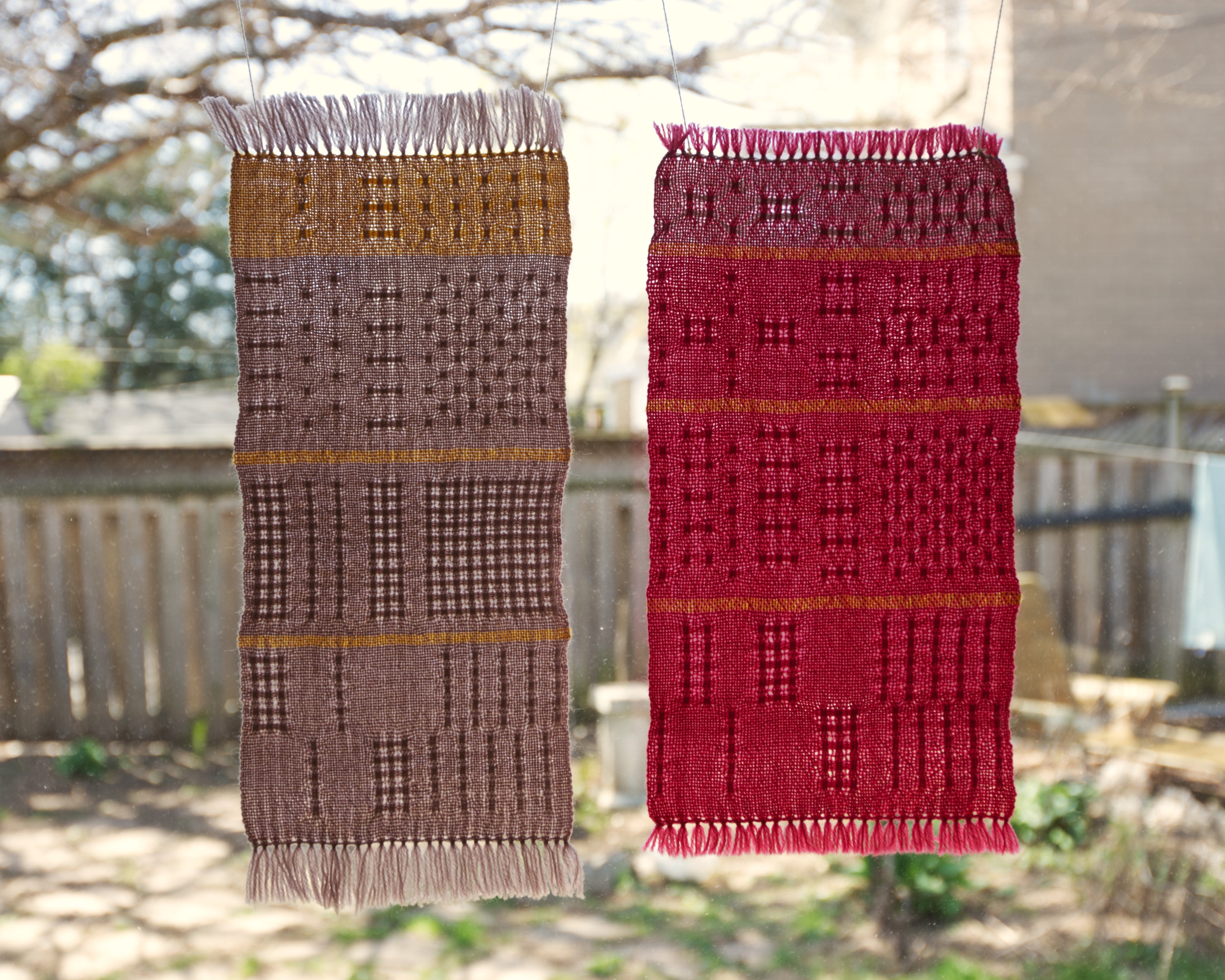Shopping Cart
*continental US addresses only
*continental US addresses only
Your Cart is Empty
This article is part two in a series about lace weaves — a magical way of interlacing threads and using skips and floats to create shape, pattern, and space. If you wish to rewind and start with article one on canvas weave, please use this link — and then hurry back to learn all about Bronson and Swedish lace!
When consulting my weaving books about Bronson lace, there’s a word that is repeated several times: old. Having several different names in its long history, you may have also met this weave as Atwater-Bronson (called so because of the popularity it gained through Mary Meigs Atwater) or Spot weave. Whatever you choose to call it, this is a lovely weave with several pattern possibilities and weave structures.
In our first article on lace weaves, we met Canvas weave, a structure with one single block, or pattern repeat, and this threading and tie up needed to weave Canvas results in no true tabby. Bronson lace gets slightly more complex in that there are two pattern blocks that can be woven individually or together, as well as tabby.
The two basic blocks of Bronson lace are:
Block A (pink): 1, 3, 1, 3, 1, 2
Block B (green): 1, 4, 1, 4, 1, 2
Tabby (blue): 1, 2

If you think this looks similar to Huck lace, you’re right! The only addition is the extra thread on shaft 2 at the end of the block. In Bronson lace, shafts 1 and 2 form the basis of both blocks, making two blocks possible on four shafts (add a block for each additional shaft you have). This plain weave base means that you can thread multiples of the same block next to one another (like A, A, B, A, A, B), which isn’t possible with Huck.
Therefore, shafts 1 and 2 form plain weave, and 3 forms Block A and 4 forms Block B. When pressing your treadles, you are either engaging Block A, Block B, or A and B together. If you’re using only one block, you’ll create tabby where you find the second block.
Anne Dixon refers to these tabby sections in The Handweaver’s Pattern Directory as “framing” the lace areas, which is a nice way to think of building your pattern using Bronson lace. While making my sample for this article, I used this framing feature in several different ways with several different effects. In Bronson lace, the ‘right’ side is the side with the warp floats — but in my opinion, both are quite nice!
You may wish to use a floating selvedge for this weave if your lace spots go right to the edge of your threading. I used four picks of plain weave at each edge and skipped the floating selvedge.
To weave the sample of Bronson lace I dove into my Array stash and used a cone of Walnut 4 leftover from my Weave Quarterly box last year (you’ll find it paired with Ode in project 2, the Daisy Chain Scarf). In my threading, I created two different threading areas, both bordered by four picks of plain weave at the selvedges.
In my treadling, I separated three different areas using four picks of Marigold 2, employing a different approach for each area.
I sett my sample at 20 EPI, which gave me slightly loose tabby and nicely pronounced lace bumps. There were several pretty effects: I liked the area where I alternated blocks A and B in warp and weft best — there’s a wonderful lattice-like effect created.

Closely related to Bronson lace is Swedish lace. Another lace that often gets called “old,” the name suggests a Scandinavian origin. In Marguerite Porter Davison’s A Handweaver’s Pattern Book, she references a piece of Swedish lace woven in a marsh that was woven in the time of the Vikings. Like Bronson, with Swedish lace you can weave two blocks on four shafts, plus tabby. Swedish lace blocks can be repeated as many times as you’d like, but you must add an end from the opposite tabby shaft in between each repeat, and then delete it at the end. Does that make sense? Let’s look at the basic blocks, as if we were weaving one of A followed by one of B:
Block A (yellow): 1, 2, 1, 2, 1
Block B (pink): 4, 3, 4, 3, 4
Tabby (blue): 1, 4

When you wish to weave two repeats of block A, you insert one end on shaft 4 between each block (in orange, above): 1, 2, 1, 2, 1, 4, 1, 2, 1, 2, 1.
You may wish to use a floating selvedge for this weave if your lace areas go right to the edge of your threading — I used four picks of plain weave at each edge and skipped the floating selvedge.
One of the many fun things about weaving is that there are many ways to write down the same pattern. The Swedish lace draft I’ve chosen to represent is the same found in Sharon Alderman’s Mastering Weave Structures and Davison — but the one you see in Dixon is quite different!
Alderman also does a little experiment in rearranging the form of Swedish lace and ends up with Bronson lace, pointing out the similarities and advantages/disadvantages of the two. When you compare them in the drawdown, they do look very alike!
She does note that Swedish lace is more restrictive; because ends are shared between blocks, you can’t add more blocks by adding more shafts. Bronson, meanwhile, can be expanded beyond four shafts because one shaft is used for each pattern unit. In Swedish lace, you also cannot weave Blocks A and B simultaneously like you can with Bronson.
I made my Swedish lace sample the same as my Bronson lace one to better compare the similar effects. I lowered the EPI by two to 18epi and used Array Flamingo 1.
I also changed the threading a bit, creating three areas of differing pattern; I kept the four picks of plain weave at the selvedges:
Like in the Bronson sampler, I separated three different areas of treadling using four picks of Marigold 2, employing a different approach for each area.


As you can tell from the drafts and side-by-side comparisons of the samples, there’s not a great visual difference between Bronson and Swedish lace — the main advantages of Bronson seem to be the ability to extend it beyond 4 shafts and to weave both blocks simultaneously. This may give you a little more flexibility when designing your weaving projects.

Next up, we’ll look at Huck and Spot Bronson to round out our exploration of lace weaves. Until then, why not give lace weaving a try? I recommend the Spring Lace Table Set (so much lovely texture!) or the Midnight Sun Table Set — what I like about both patterns is that they use more than one color, which creates pops of warp or weft spot colors, increasing the visual effect of the texture.
Mastering Weave Structures by Sharon Alderman, Interweave Press, 2004.
A Handweaver’s Pattern Book by Marguerite Porter Davison, 1975.
The Handweaver’s Pattern Directory, by Anne Dixon, Interweave Press, 2007.
Amanda Rataj is an artist and weaver living and working in Hamilton, Ontario. She studied at the Ontario College of Art and Design University and has developed her contemporary craft practice through research-based projects, artist residencies, professional exhibitions, and lectures. Subscribe to her studio newsletter or follow her on Instagram to learn about new weaving patterns, exhibitions, projects, and more.